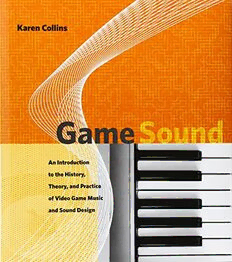
Game sound : an introduction to the history, theory, and practice of video game music and sound design PDF
Preview Game sound : an introduction to the history, theory, and practice of video game music and sound design
M D D A L I M # 9 7 2 6 1 7 0 7 /0 5 /0 8 C Y A N M A G Y E L O B L K Game Sound Game Sound An Introduction to the History, Theory, and Practice of Video Game Music and Sound Design KAREN COLLINS The MIT Press Cambridge, Massachusetts London, England (cid:1) (cid:1) (2008MassachusettsInstituteofTechnology All rights reserved. No part of this book may be reproduced in any form by any electronic or mechanical means(includingphotocopying,recording,orinformationstorageandretrieval)withoutpermissioninwriting fromthepublisher. MITPressbooksmaybepurchasedatspecialquantitydiscountsforbusinessorsalespromotionaluse.For information, email [email protected] or write to Special Sales Department, The MIT Press, 55HaywardStreet,Cambridge,MA02142. This book was set in Melior and MetaPlus on 3B2 by Asco Typesetters, Hong Kong, and was printed and boundintheUnitedStatesofAmerica. LibraryofCongressCataloging-in-PublicationData Collins,Karen,1973–. Gamesound:anintroductiontothehistory,theory,andpracticeofvideogamemusicandsounddesign/ KarenCollins. p. cm. Includesbibliographicalreferences(p. )andindex. ISBN978-0-262-03378-7(hardcover:alk.paper) 1.Videogamemusic—Historyandcriticism. I.Title. ML3540.7.C65 2008 781.504—dc22 2008008742 10 9 8 7 6 5 4 3 2 1 TOMYGRANDMOTHER Contents Preface ix CHAPTER1 Introduction 1 GamesAreNotFilms!But... 5 CHAPTER2 PushStartButton:TheRiseofVideoGames 7 InvadersinOurHomes:TheBirthofHomeConsoles 20 ‘‘WellItNeedsSound’’:TheBirthofPersonalComputers 28 Conclusion 34 CHAPTER3 InsertQuartertoContinue:16-BitandtheDeathoftheArcade 37 NintendoandSega:TheHomeConsoleWars 39 PersonalComputersGetMusical 48 MIDIandtheCreationofiMUSE 51 AmigaandtheMODFormat 57 Conclusion 59 CHAPTER4 PressReset:VideoGameMusicComesofAge 63 HomeConsoleAudioMatures 68 OtherPlatforms:Rhythm-Action,Handhelds,andOnlineGames 73 Conclusion 81 CHAPTER5 GameAudioToday:Technology,Process,andAesthetic 85 TheProcessofTakingaGametoMarket 86 TheAudioProductionProcess 88 ThePre-ProductionStage 89 TheProductionStage 95 ThePost-ProductionStage 102 Conclusion 105 CHAPTER6 SynergyinGameAudio:Film,PopularMusic,andIntellectualProperty 107 PopularMusicandVideoGames 111 TheImpactofPopularMusiconGames,andofGamesonPopularMusic 117 Conclusion 121 viii Contents CHAPTER7 Gameplay,Genre,andtheFunctionsofGameAudio 123 DegreesofPlayerInteractivityinDynamicAudio 125 TheFunctionsofGameAudio 127 ImmersionandtheConstructionofthe‘‘Real’’ 133 Conclusion 136 CHAPTER8 CompositionalApproachestoDynamicGameMusic 139 NonlinearityinGames 142 TenApproachestoVariabilityinGameMusic 147 Conclusion 164 CHAPTER9 Conclusion 167 Notes 173 Glossary 183 References 189 Index 197 Preface When I first began writing about video game audio in 2002, it seemed somehow necessarytoprefaceeacharticlewithaseriesoffactsandfiguresabouttheimpor- tance of the game industry in terms of economic value, demographics, and cul- tural impact. It is a testament to the ubiquity of video games today that in such a short time it has become unnecessary to quote such statistics to legitimize or val- idate a study such as this. After all, major newspapers are reporting on the popu- larity of Nintendo’s Wii in retirement homes, Hollywood has been appropriating heavily from games (rather than the other way around), and many of us are pre- tending to check our email on our cell phone in a meeting when we are really playingLumines. Attentiontogameaudioamongthegeneralpopulaceisalsoincreasing. The efforts of industry groups such as the Interactive Audio Special Interest Group (IAsig), Project Bar-B-Q, and the Game Audio Network Guild (GANG) have in recent years been advancing the technology and tools, along with the rights and recognition, of composers, sound designers, voice actors, and audio pro- grammers.Aspublicrecognitionrises,academiaisslowlyfollowing:newcourses in game audio are beginning to appear in universities and colleges (such as those at the University of Southern California and the Vancouver Film School), and new journals—such as Music and the Moving Imagepublished by University of Illinois Press, and Music, Sound and the Moving Image published by the Univer- sityofLiverpool—areexpandingthefocusbeyondfilmandtelevision. In some ways, this book began when my Uncle Tom bought me one of the early forms of Pong games some time around 1980, and thus infected me with a love for video games. I began thinking about game audio more seriously when I was completing my Ph.D. in music, and began my research the day after my dis- sertation had been submitted. The research for the book continued during my time as postdoctoral research fellow at Carleton University in Ottawa, funded by the Social Sciences and Humanities Research Council of Canada, under the su- pervision of Paul The´berge, who provided encouragement and insight. It was fin- ished in my current position as Canada Research Chair at the Canadian Centre of Arts and Technology at the University of Waterloo, where I enjoy support from the Government of Canada, the Canadian Foundation for Innovation, and the OntarioMinistryofEconomicDevelopmentandTrade. The years of research and writing could not have been possible without the support of family and friends (special thanks to Damian Kastbauer, Jennifer Nichol, Tanya Collison, Christina Sutcliffe, Parm and Paul Gill, Peter Taillon, Ruth Dockwray, Holly Tessler, Lee Ann Fullington, and my brother James): Your kindness and generosity are not forgotten. The Interactive Audio Special Interest
